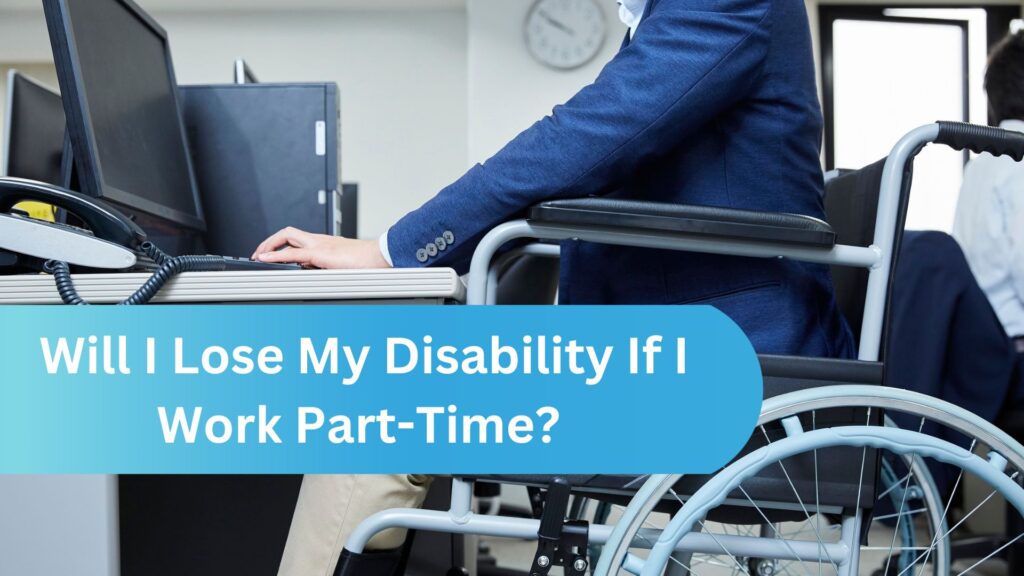What You Need to Know to Stay Informed and Protected
For many people receiving disability benefits, the idea of returning to work—even part-time—is hopeful yet full of questions. One of the most common is: “Will I lose my disability benefits if I take a part-time job?”
The good news is: not necessarily — but there are important rules, limits and reporting requirements you must follow to protect your benefits.
Below is a detailed guide to help you understand how working part-time can affect your disability benefits under Social Security Administration (SSA) programs such as Social Security Disability Insurance (SSDI) and Supplemental Security Income (SSI).
1. The Two Main Programs: SSDI vs. SSI
Before delving into part-time work rules, it’s critical to know which program you’re receiving, because the rules differ:
-
SSDI: For individuals who paid into Social Security through work and have a qualifying disability.
-
SSI: A needs-based program for those with disabilities (or blindness or age 65+) who have limited income and resources.
Each program has its own income limits, work incentives and reporting rules. Understanding your program will help you know how part-time work will impact you.
2. Working Part-Time on SSDI: What You Can and Cannot Do
For SSDI recipients, the SSA has established a system of work incentives so that returning to work part-time (or trying work) won’t automatically mean losing benefits. Key rules include:
Trial Work Period (TWP)
You are allowed to test work without losing your SSDI benefits for up to nine months (within a rolling 60-month period). During this time, you can earn any amount and still receive your full benefit — as long as you report the work and you still have a disabling impairment.
Extended Period of Eligibility (EPE)
After the TWP ends, you enter a 36-month window (the Extended Period of Eligibility) during which your SSDI benefits will continue for any month your earnings fall below the Substantial Gainful Activity (SGA) limit. If your monthly earnings exceed SGA, benefits may stop for that month or longer.
SGA (Substantial Gainful Activity) Limit
For non-blind SSDI recipients in 2025, the SGA limit is $1,620/month. For blind recipients, it is higher (around $2,700/month for 2025) before SSA considers the work “substantial.”
What This Means for Part-Time Work
-
Yes — you can work part-time while on SSDI without immediately losing benefits.
-
If you keep your earnings below the SGA limit after your TWP, you may continue receiving SSDI benefits.
-
You must report your earnings and work activity to SSA. Failure to report can cause overpayments or termination.
-
Track your expenses: Some work-related disability costs (like special equipment, transportation) may be deductible, reducing countable income.
3. Working Part-Time on SSI: Different Rules, More Sensitivity to Income
SSI is more income-sensitive because it’s needs-based. Here are key points:
Countable Income and Monthly Benefit
Your SSI benefit will be reduced as you earn money from work. The SSA uses a formula where initial earned income exclusions apply (like the first $65 you earn, plus a $20 general exclusion) and then counts half of the remaining earned income against your SSI benefit.
Income Limits
If your countable income exceeds the state/federal limit, your SSI cash payment may end. However, you might still keep Medicaid/Medicare in some situations.
What This Means for Part-Time Work
-
You can work part-time on SSI — but your benefit check will likely be smaller.
-
Example: If you earn $600/month part-time, your countable income after exclusions might reduce your SSI payments. Nolo+1
-
The key is: SSI doesn’t always stop immediately due to work, but the more you earn, the more benefits can be reduced or stopped.
-
Reporting is critical—always report your work and earnings.
4. Step Checklist Before Taking a Part-Time Job
Before you start working part-time, run through this checklist:
-
Verify your program: SSDI or SSI — your rules differ.
-
Know your SGA / income limits: For SSDI, know the SGA amount ($1,620+ in 2025). For SSI, estimate your countable income.
-
Report to SSA: Starting work, stopping work, change in hours—report promptly.
-
Keep documentation: Pay stubs, job duties, hours, disability-related expenses—you may need these if SSA reviews your case.
-
Use work incentives: For example, the “Ticket to Work” program, or offsetting expenses for SSI or SSDI recipients.
5. Real-Life Example: Part-Time Work with SSDI
Imagine you receive SSDI, and you begin a part-time job earning $1,000/month.
-
You’re still within SGA ($1,620).
-
You report your work to SSA.
-
You’re in your TWP (nine months) or EPE window.
Result: Your benefits may continue unaffected for now. But if your earnings rise above $1,620/month and your TWP/EPE rules no longer apply, SSA may reduce or stop benefits.
6. Real-Life Example: Part-Time Work with SSI
You receive SSI and decide to work part-time earning $600/month.
-
SSA excludes $65 and $20, then counts half of the rest as income.
-
Your SSI check is reduced accordingly.
-
If your countable income plus resources exceed the limit, your SSI cash benefit may end—but you might still keep Medicaid.
Result: You keep working part-time, earn extra income, and the benefit decreases—but you haven’t lost everything.
7. Things to Watch & Common Mistakes
-
Not reporting work: Big risk. Always inform SSA when you start or stop working, or if your income changes.
-
Assuming “part-time” means “safe”: Part-time hours aren’t a guarantee. The key is earnings relative to SGA/income limits.
-
Ignoring expense deductions: If you have disability-related work expenses, they might reduce countable income.
-
Not tracking your months: For SSDI, when you start TWP or EPE matters.
-
Assuming benefits last forever: Earnings may trigger reviews; your condition or ability may improve and SSA may reassess.
8. Summary: Will You Lose Your Disability if You Work Part-Time?
Short answer: It depends. You might keep your benefits, but you must follow the rules:
-
On SSDI: You can work part-time and still receive benefits if you stay under the SGA income limit (or use TWP/EPE) and report work.
-
On SSI: You can work and receive benefits, but your check will likely be reduced as your income rises—there’s more risk of losing the cash benefit if you exceed limits.
-
In both cases: Reporting, tracking income, and staying informed are critical.
Frequently Asked Questions (FAQ)
Q: How many hours per week can I work and keep my benefits?
A: There’s no specific hourly limit. It’s about earnings. For SSDI, focus on monthly income vs. SGA. For SSI, countable income matters.
Q: If I stop working, can my benefits start again?
A: Yes — for SSDI, you may be eligible for “expedited reinstatement” if your benefits stopped and you can’t work again because of your disability. For SSI similar rules may apply.
Q: Will working part-time automatically trigger a review of my disability?
A: Not automatically, but earning above SGA or reporting work may prompt SSA to review whether you still meet the disability standard.
Q: What happens if I earn more one month than the limit but less in others?
A: For SSDI, one month over SGA during EPE may cause benefits to stop for that month. It can get complex — monitoring is key.
Final Thoughts
Working part-time while receiving disability benefits is possible—and often encouraged by SSA via incentives. But “possible” doesn’t mean “unlimited.”
Your success depends on staying within the rules for your program (SSDI or SSI), accurately reporting work, and keeping detailed records.
With the right approach, you can pursue part-time employment without losing your benefits and retain both income and hope for future improvement.


